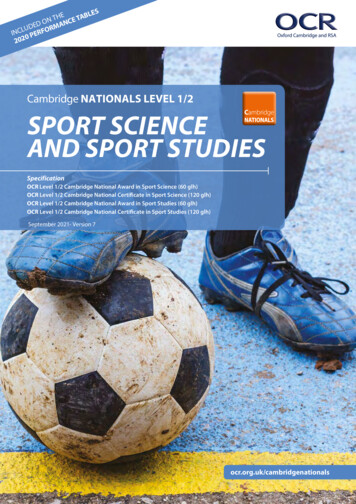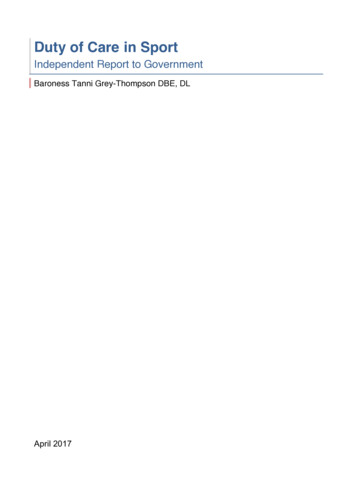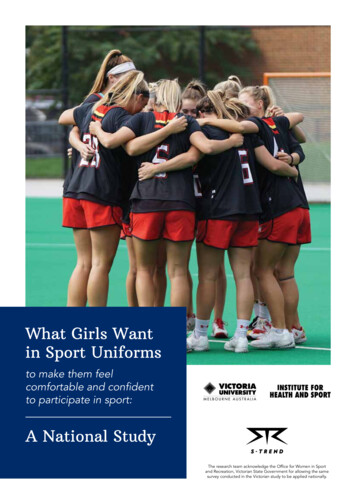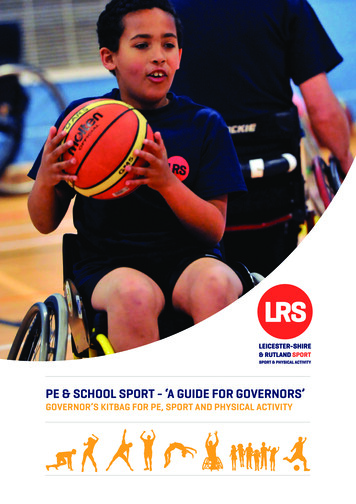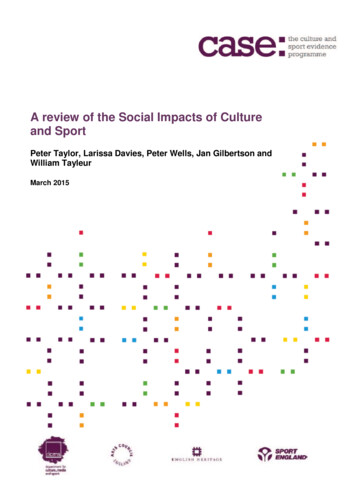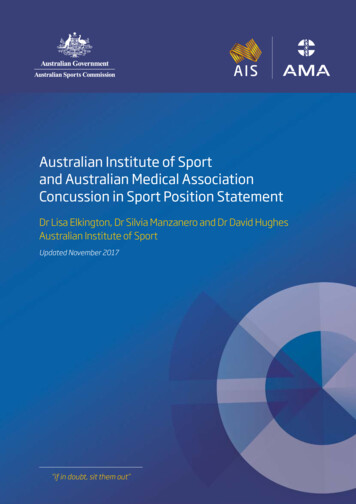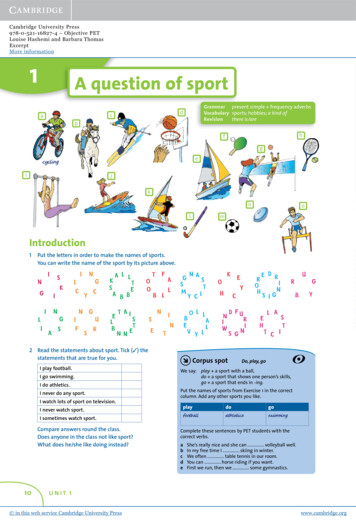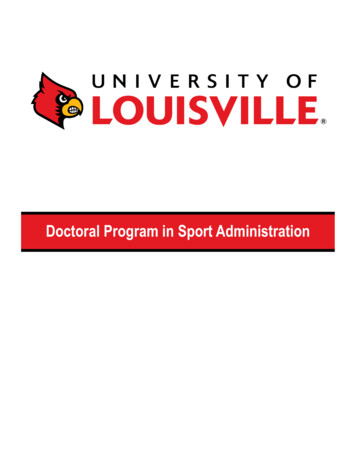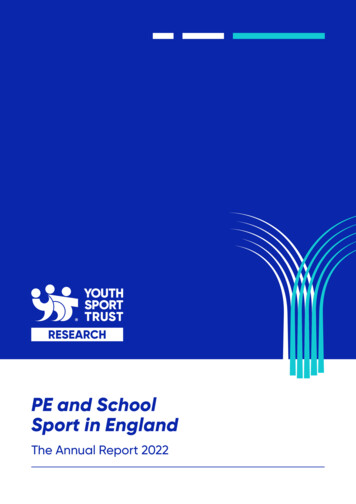
Transcription
PE and SchoolSport in EnglandThe Annual Report 2022
ContentsAbout the Youth Sport Trust03Introduction04Why PE, physical activity andschool sport are so important05Young people’s health and wellbeing06Young people’s activity levels07PE, physical activity, and sport in school09Daily physical activity, PE, play and sport11References13Recommended further reading1502 — Youth Sport Trust: PE and School Sport in England
About theYouth Sport TrustThe Youth Sport Trust is a children’scharity founded in 1995 to harness thepower of play and sport in children’seducation and development.Our visionA future where every childenjoys the life-changingbenefits of play and sportOur missionEquip educators andempower young peopleto build bright futuresTogetherWe create opportunitiesfor everyone tobelong and achieveRead our Inspiring Changemakers,Building Belonging strategy:www.youthsporttrust.org/strategy03 — Youth Sport Trust: PE and School Sport in EnglandInspiringchangemakers,building belongingOur strategy 2022-352022 EDITION
Introductionfrom our CEOThis report outlines the current state of PE, schoolsport and physical activity in England and the issuesand challenges facing young people today.There is a wealth of research and insight which informs our understanding ofthe importance of activity in children’s lives and their engagement in PE andsport, with more being published every year. However, we need to do moreto bring this evidence to public attention as a matter of urgency. The aimof this annual report is to build a true “state of the nation” picture for thoseworking in this space, but also for parents and carers, policy makers and otherpublic influencers who can become changemakers for sport and play.In our new 2022 to 2035 strategy, ‘Inspiring Changemakers, Building Belonging’,one of the big challenges we identify is to raise public awareness of a declinein physical activity levels and the status and provision of PE and sport in someschools, and why it is so important to tackle this. To live in a world whereevery child gets to enjoy the life-changing benefits of play and sport, weneed to educate and transform society’s attitudes and perceptions.This report serves as a digest of the latest evidence, it presents key insight from partnersgenerated by a range of organisations, and shares new research commissioned byour charity to benchmark public sentiment. This research has uncovered that only twoin five parents are aware that their children should be physically active for 60 minutesevery day – the minimum amount recommended by the Chief Medical Officer.This remarkable finding illustrates the scale of the challenge we face and maygo some way to explaining the persistently high levels of inactivity among youngpeople in recent years.We would like to express our thanks to those organisations, partners, and stakeholderswhose research and insight contributes to this report, and to those schools andeducators who work so hard day in and day out to help children be healthy, happyand achieve their potential in life.We are committed to updating this report on an annual basis. I hope you find ithelpful and it provides a useful indicator of the progress being made at a nationallevel to better prioritise PE, school sport and physical activity in young people’s lives.Ali Oliver MBEChief Executive Officer, Youth Sport Trust04 — Youth Sport Trust: PE and School Sport in England
Why PE, physicalactivity and schoolsport are so importantA young person who is physically active andplays sport on a regular basis will have AINFUNCTION Cardio-vascularfitness Happiness Less lonely Healthy weight Resilience More trusting Equipped to tackleanxiety and stress Improvedcommunicationand teamwork skillsEvidence shows beingphysically active impacts onprogress and achievement.It improves the brain bystimulating growth in thepart of the brain responsiblefor learning and memory.Young people’s ability toconcentrate also improvesafter physical activity. Strength Co-ordination Energy levels Improved moodthrough releaseof ‘feel good’endorphinsGiven the myriad benefits that come from sport and physical activity, it is vital that young peopleare given opportunities to build and develop skills and active habits throughout their childhood.Only through play and movement throughout childhood will they develop ‘physical literacy’(the motivation, confidence, physical competence, knowledge and understanding of individualsand how this influences the way they value and take responsibility for engaging in physical activitiesfor life.1) Schools are in a unique position to provide opportunities to participate and to help buildthese essential physical literacy skills that lead to lifelong engagement and participation.In addition to the health and wellbeing benefits, there is a growing body of research, both in the UKand internationally, to suggest a positive association between participation in physical activity andacademic performance in young people. A review of academic literature completed in 2022 by theYouth Sport Trust Research and Insight team2 highlighted the important role that quality physicalactivity and PE can play in supporting a child at school. Evidence shows that physical activity involvingdecision making, like team games for example, can be particularly beneficial. Incorporating activity intolessons can support cognition and learning. Physical activity can also enhance cognitive function, brainstructure and function3 as well as improving accuracy in visual working memory and inhibitory control.4Research demonstrates that children who are fitter outperform young people with lower fitness on testsof cognitive function.5 Data from Sport England’s Active Lives (Children & Young People) survey alsofound that there is a positive association between children who participate in more sport and physicalactivity and their levels of mental wellbeing, resilience, and attitudes towards their community.05 — Youth Sport Trust: PE and School Sport in England
Young people’shealth and wellbeingA record one-in-four Year 6 pupils are obese. 2020/21 saw the largest everincrease in childhood obesity.6Almost three quarters (73%) of school leaders reported children returningto school with poor levels of physical fitness following Covid-19 restrictions.7The proportion of children unhappy with their school lives has leapt from 1 in 11ten years ago to 1 in 8.8Children from poorer backgrounds are the least confident being active. 51%of 11-to-16-year-olds in the D and E socio-economic groups rate themselves asconfident taking part in physical activity, compared to 75% of 11-to-16-year-oldsin the A and B socio-economic groups.9Research conducted during 2021 found that wellbeing is the top factor thatparents look for when choosing their child’s secondary school, demonstratingthe value parents place on wellbeing.10Now, more than ever, children need the physical, emotional, and social wellbeing benefits that comefrom sport and physical activity.Children who are regularly active (play sports or active games) have higher levels of wellbeing compared tochildren who are not. Children who are not regularly active have been found to be around twice as likely tohave low wellbeing as those who do so at least once a week.11Even before the pandemic, there had been significant declines in young people’s wellbeing over the lastdecade with children reporting falls in overall life satisfaction and happiness with their friends, appearance,and school.8 Declines were further impacted by Covid-19 lockdowns.An estimated 306,000 10–15-year-olds are unhappy with their lives. Whilst many young people havebeen incredibly resilient, still around a quarter of a million children are not coping well with changes theyexperienced during the pandemic and roughly 3 in 10 are not optimistic or are indifferent about the future.8Over a third (36%) of parents believe that their child’s physical wellbeing has been negatively impacted bythe Covid-19 pandemic, while 43% believe that their child’s mental wellbeing has been negatively impactedand 53% believe social wellbeing has suffered.12 Youth Sport Trust’s Active Recovery Curriculum researchfound schools reported a notable loss of fitness for many pupils and in some cases weight gain when theyreturned to school.13Growing inequalityDeep-rooted and growing inequality as a result of lived experience, geography or characteristics is leadingto poorer health and educational outcomes for many young people. Children from poorer backgroundsface more barriers to accessing opportunities to be active, missing out on the associated benefits as aresult. They are less confident in taking part in physical activity and less likely to see the benefits of PE andbeing active.906 — Youth Sport Trust: PE and School Sport in England
Young people’sactivity levelsFewer than half of all children and young people in England (44.6%) are meetingthe Chief Medical Officer’s guidelines which advise that children aged between 5and 18 do an average of at least 60 minutes of sport and physical activity a day.14Children’s activity levels have fallen by 13% compared to pre-pandemic levels.There has also been an increase in sedentary time with young people spending25 minutes longer a day being inactive.15Existing inequalities widened since the start of the pandemic:—Young people from the least affluent families remain the least active and arefalling further behind.—Children from Black and South Asian communities are less active than theoverall average.1454% of children would like to do more exercise or sport than they are currentlydoing - up from 44% in 2014.9Since the launch of Sport England’s Active Lives (Children & Young People) survey in 2018, consistentlymore than half of young people have failed to meet the Chief Medical Officer’s target of averaging60 minutes per day of moderate to vigorous physical activity. The 2021 report found that activitylevels had declined.Additionally, the latest report shows that fewer young people are enjoying taking part in sportand physical activity, and fewer are finding it easy. More than 9 out of 10 children report thatthe way they play has changed since the pandemic. Children are spending less time playingoutside and with friends than before.Prior to Covid-19, one in four children were unable to swim 25 metres by the end of primary school.As a result of the pandemic, lockdowns and restrictions, this is expected to increase to three in fivechildren by the 2025-26 academic year.16 Since the pandemic, 206 swimming pools have closedeither permanently or temporarily. Current trends suggest that the number of available swimmingpools and facilities could decrease by more than 40% by the end of the decade17, reducing theavailable opportunities for all to engage in swimming. Covid-19 restrictions have meant that 1.88million children across all year groups will have missed out on swimming participation duringthe 2020/21 academic year, according to research from Swim England. It predicts that almost1.2 million children leaving primary school between 2021 and 2026 will be unable to swim.1607 — Youth Sport Trust: PE and School Sport in England
Young people’sactivity levelsInequality and disabilityPre-determined factors continue to negatively influence young people’s activity levels, with thosefrom a disadvantaged or black ethnic background, being less active than their peers.14 This mirrorsevidence from the National Childhood Measurement Programme, with obesity prevalence highest forBlack children both in reception and year 6.6 Covid-19 has had a bigger impact on the activity levels ofthose from the least affluent families, with a decrease in activity levels by 3.4% compared to no changein activity levels for those from the most affluent families. The division is particularly stark in activitiessuch as swimming: Swim England reports that by 2026, 34% of children from lower socio-economicbackgrounds will be able to swim 25 metres, compared to 77% of those from more affluent families.14 Forsome children, school may offer them their only opportunity to take part in sport during their week, soit’s vital that access to PE and school sport is maintained to try to address some of these inequalities.Whilst the latest Active Lives (Children & Young People) survey from Sport England shows littledifference in activity levels between those with and without a disability or long-term healthcondition, evidence does show that disabled children are less likely than non-disabled childrento take part in sport and activity all the time at school and in informal settings such as at thepark.18 Research from Activity Alliance shows that disabled children’s activity levels decreasesignificantly as they get older. Activity levels for disabled and non-disabled children are similarwhen they first start school (Key Stage 1 - 83% during term-time compared to 84%). However, byage 11, disabled children are less likely to be ‘active or fairly active’ (Key Stage 2 - 77% vs 85%).The gap widens more significantly by the time they are 16 (Key Stage 4 - 52% vs 72%).18Gender continues to be a factor that influences activity levels. Historically, girls have consistentlyreported lower activity levels and more barriers to participation than boys. This year, we haveseen activity levels even out across the genders but unfortunately only because boys’ levels ofphysical activity have fallen. This is particularly evident for boys of secondary school age.14Gender influences participation and engagement in physical activity. Girls are more likely to reportbarriers to participation than boys, with lack of confidence and peer pressure being some of the biggestbarriers. Increasingly, girls are also more likely to see their periods as a barrier to participation, with 37%of girls saying that their periods stopped them being active this year, which is an increase from 27% in2018/19.19 By their teenage years, 78% of girls understand the importance of an active lifestyle but only28% really enjoy taking part in physical activity.20 Work by Women in Sport found that 43% of girls whoconsidered themselves “sporty” at primary school no longer felt that way by their teenage years. Thisled to them dropping out of regular exercise, with the concern that this continues into adulthood.2108 — Youth Sport Trust: PE and School Sport in England
PE, physicalactivity, and sportin school86% of young people believe PE lessons are important and 77% saythey enjoy them.939% of parents believe that young people should get more time forplay and sport during the school day.22State secondary schools in England taught 284,000 hours of PE in 2021– down 13% from 326,000 hours in 2011.23There are 23,513 PE teachers in England – down from 26,005 in 2011.23Children who attend special schools are more likely to be inactive– 39% are inactive, compared to 24% in non-SEN schools.18Evidence shows that Government funding for the primary PE and Sport Premiumhas had positive effects on physical activity provision in primary schools.24The research among schools showed that:— almost 9/10 respondents thought the profile of PE / Sport in supporting wholeschool improvement had increased— almost 9/10 respondents thought that the confidence, knowledge and or skillsof all staff in teaching PE had increasedSchools play a unique role in being able to shape young people’s attitudes to sport and physicalactivity. The National Curriculum states that every young person is entitled to experience highquality PE. Ofsted go further, arguing that ‘High quality PE is a physical and cultural entitlement’25and the Government recommends that schools should be providing 2 hours of PE a week.However, with pressure to deliver exam results, PE has often been deprioritised in favour of othersubjects, resulting in a reduction in PE hours taught over the past decade. PE time also reducesas a child progresses through secondary school.26 Even for those offering 2 hours, valuabletime can be lost in changing and setting up, which can mean that less time is available forlearning or activity.27, 28 Evidence suggests around 40.5% of a PE lesson is spent doing moderateto vigorous physical activity.29 During the pandemic, some schools found that encouragingchildren to arrive at school in PE kit allowed them to spend more time on activity.1309 — Youth Sport Trust: PE and School Sport in England
PE, physicalactivity, and sportin schoolOn returning to school after lockdown, more than half of primary schools and almost two-fifthsof secondary schools said that they had reduced hours for some subjects, particularly musicand PE in their school while they helped children catch-up.30 This is despite evidence to showthat “Active Recovery” strategies were able to reap benefits when implemented. Researchcommissioned by the Youth Sport Trust13 found that schools which implemented an Active RecoveryCurriculum as pupils returned to school saw improved social, academic, emotional, and physicalwellbeing for young people. A number of academic reviews also suggest that an active learningapproach may be beneficial for cognitive performance and academic achievement.31High quality PE starts with teacher training. Current primary teacher initial training does not sufficientlyprepare primary school teachers to teach PE32 with teachers often lacking confidence and understandingof the subject. This leads to sub-optimal experiences for pupils. Research from the Youth Sport Trustfound that there is a lack of confidence and competence of mainstream secondary teachers to deliverinclusive PE to children with special educational needs and disabilities, despite a willingness to do so.3370% of secondary schools in England are currently benefitting from the secondary teachertraining programme which is a Sport England National Lottery funded programme workingwith the Association for Physical Education, the Youth Sport Trust, Activity Alliance, and theTeaching Schools Council. Research conducted as part of this programme showed howstaff could positively influence their pupils. For instance, where members of staff are morephysically active, they are more likely to encourage inactive students to be active and havepositive perceptions of sport and physical activity to support young people’s wellbeing.34Young people’s experience of PEPE lessons are valued by young people in the UK, with 86% agreeing that they are important9 and77% enjoying them, however, more could be done to increase overall enjoyment. There is a disparityin enjoyment of PE between girls (72%) and boys (82%). Women in Sport report that almost two thirdsof girls quit sport by the time they reach puberty.35 Research shows that offering a range of activitiesand actively tackling some of the common barriers to activity can help maintain activity levels.36More than half of children say that they would like to do more exercise or sport than they are currentlydoing, with many wanting a greater say in the activities they do in PE and after-school clubs.Being taught by peers can be motivational, particularly for girls and disabled young people. Overa third of children and almost half of those with a disability would prefer to be taught by someonetheir own age, highlighting the need for relatable role-models to encourage participation.9Young people’s levels of confidence and competence to participate in sport and physical activityhas been negatively impacted by the Covid-19 restrictions. This is concerning given we knowthese factors are key to building longer-term engagement and participation in activity andthat children who frequently play sports or exercise tend to have higher levels of wellbeing.14010 —Youth Sport Trust: PE and School Sport in England
Daily physical activity,PE, play and sport —a matter of national concernMore work needs to be done to elevate the importance of PE and school sport, ensuring that everyoneis aware of its importance and relevance in ensuring that children achieve their potential in life. Whilstyoung people recognise that PE and physical activity can help them to be fit and healthy, they areless likely to recognise the other benefits which come from high quality PE such as improvementsin wellbeing, cognition or the development of life skills including leadership and team building.UK parents are supportive of school sport with 81% believing that schools should be ensuringthat every pupil is physically active for at least 30 minutes a day whilst in school and withsimilar numbers (78%) calling for schools to provide at least 2 hours a week of PE to everypupil. More than two thirds of parents (68%) believe that PE should be a core subject on thenational curriculum10 and over a third (39%) believe that children should get more time forsport and play during the school day. Parents who say that they had a positive experience ofPE when they were at school are more likely to recognise the benefits of PE for their children,again demonstrating the long-term benefits that come from high-quality school PE. 22Currently, the assessment, benchmarking and tracking of pupil progress within PE is inconsistent and asa result, young people can leave school without anything tangible to demonstrate their achievements.This can lead to PE being seen as a less important subject when put alongside subjects with moredemonstrable outcomes.In 2021 the Association for Physical Education’s Taskforce on the Future of Physical Education publisheda report37 with recommendations to put Physical Education at the heart of school life. Headlinerecommendations included:— The need for an urgent review by Government of the status of PE as a foundation subject.— For PE to be classified a core subject with clear goals and priorities and assessment,monitoring, and reporting around the holistic development of the child.— To have clarity and transparency around what schools can affect and not through highquality PE, to make them responsible for the whole life experience of young people.In March 2022 the Youth Sport Trust commissioned YouGov to carry out research into the attitudes andperceptions of UK adults and parents towards sport, play, physical activity and PE. We intend to repeatthe exercise annually throughout the period of our 2022 to 2035 strategy.22Findings from the initial survey showed the majority of parents (66%) say that the wellbeing of theirchildren was more important than their academic achievement. Additionally, 76% of parents agree thatthe teaching of interpersonal skills is now even more important for young people growing up in today’sdigital age than it was for previous generations.Over three quarters of UK adults are concerned that children are not getting enough physicalactivity (76%) and spending too much time online and not enough time with each other (77%). Parentsare even more likely to be concerned about both physical activity (81%) and time online (83%).011 — Youth Sport Trust: PE and School Sport in England
Daily physical activity,PE, play and sport —a matter of national concernGiven this, it is no surprise that 89% of parents believe that sport and play are importantparts of every young person’s education and development: 74% of parents agree thatsport and play help young people’s mental wellbeing, 66% agree that sport and play helpyoung people’s social wellbeing and 70% believe that it helps with children’s life skills.However, there’s still some way to go to build understanding of the importance of physicalliteracy and in ensuring children are sufficiently active throughout their day: 61% of parentsdo not understand what is meant by physical literacy, although when the concept of physicalliteracy was explained to them, seven in ten parents (70%) said that they thought that theirchild’s physical literacy was as important as their language literacy and numeracy.Similarly, whilst most parents believe that sport and play are beneficial, many are unaware of the ChiefMedical Officer’s guidelines that young people should be active for an average of 60 minutes everyday. In fact, parental awareness of the 60 active minute guidance has fallen over time. In 2021 48% ofparents thought children should be doing 60 daily active minutes or more compared to 36% in 2022.The amount of daily physical activity parents thinkthat 5 to 18 year old children should be doing40%35%10%% of parents30%25%20%38%15%10%26%24%5%0%Less than 30 minutes30 to 59 minutes60 minutes (green)or more (orange)To transform society’s perceptions and attitudes towards the importance of physical literacy, playand sport, it’s good to know that some parents are keen to become more actively involved in makingthe change. A quarter (23%) would be prepared to speak to their child’s school to encourage them toprovide more PE or school sport and 16% would be prepared to speak to local leaders on the issue.early half (45%) of parents would support a national campaign to get young people more active.22012 —Youth Sport Trust: PE and School Sport in England
References1 International Physical LiteracyAssociation, 2022. Physical Literacy for All:An active today for an active tomorrow2 Youth Sport Trust. 2022. Evidence paper– The link between Physical Activity andAttainment in Children and Young People.Accessed: and-attainmentevidence-paper-january-2022.pdf3 Donnelly, Joseph E. Ed.D, FACSM(Co-Chair); Hillman, Charles H. Ph.D.Co-Chair; Castelli, Darla Ph.D.; Etnier,Jennifer L. Ph.D., FACSM; Lee, SarahPh.D.; Tomporowski, Phillip Ph.D., FACSM;Lambourne, Kate Ph.D.; Szabo-Reed,Amanda N. Ph.D. Physical Activity, Fitness,Cognitive Function, and AcademicAchievement in Children, Medicine &Science in Sports & Exercise: June 2016- Volume 48 - Issue 6 - p 1197-12224 Lorna M. Hatch, Ryan A. Williams, Karah J.Dring, Caroline Sunderland, Mary E. Nevill,Mustafa Sarkar, John G. Morris, Simon B.Cooper (2021) The Daily Mile : Acute effectson children’s cognitive function and factorsaffecting their enjoyment, Psychologyof Sport and Exercise,Volume 575 Williams RA, Cooper SB, Dring KJ, HatchL, Morris JG, Sunderland C, Nevill ME. Effectof football activity and physical fitness oninformation processing, inhibitory controland working memory in adolescents.BMC Public Health. 2020 Sep 14;20(1):1398.doi: 10.1186/s12889-020-09484-w.PMID: 32928161; PMCID: PMC74887496 Public Health Data. 2021.National childhood measurementprogramme 2020/217 Youth Sport Trust. 2020. Returningto school after ght/research/returningto-school-after-covid-19– Academic year 2020-21 ic%20Year%202020-21%20Report.pdf?VersionId 3jpdwfbsWB4PNtKJGxwbyu5Y2nuRFMBV15 Salway et al. IntJ Behav Nutr PhysAct. 2022. Accelerometer measuredphysical activity and sedentary timeamong children and their parents in theUK before and after COVID 19 lockdowns:a natural experiment. https://doi.org/10.1186/s12966-022-01290-416 Swim England 2021. The impact ofCoronavirus on school swimming andwater safety. Accessed by: irus-schoolswimmingreport/#: :text 5%20metres%20unaided17 Swim England 2021. A decade of decline.Accessed via. ne/18 Activity Alliance 2020. My active Future:including every child. Accessed via rch-202019 Youth Sport Trust. GirlsActive research 202120 Women in Sport/Sport England.2019. Reframing Sport for Teenage Girls:Building Strong Foundations for TheirFutures. df8 The Children’s Society. 2021. The GoodChildhood report. Accessed: 21 Women in Sport/Sport England. 2022.Reframing sport for Teenage Girls: TacklingTeenage Disengagement. 9 Youth Sport Trust/ForesightFactory. 2021. Class of 203522 Youth Sport Trust/YouGov.2022.PE & School Sport survey10 Youth Sport Trust/YouGov/Gregson Family Foundation.2021. Wellbeing survey 202123 Statistics: school workforce - GOV.UK. 2021 Available at: cs-school-workforce11 The Children’s Society. The GoodChildhood Report 2014. 25–30 (2014).12 Save the Children/Beano Brain.May 2021. Omnibus research13 Youth Sport Trust/spear. 2021. ActiveRecovery research. ar-cccu-arc-evaluation-report.pdf?id a4m3z000004cUaNAAU&order 1& ga 2.74316626.1132923114 Sport England. 2021. Active LivesChildren and Young People Survey24 Department for Education. 2019.Primary PE and Sport Premium SurveyJuly 2019 t/uploads/system/uploads/attachment data/file/816676/Primary PE and SportPremium Survey research report.pdf25 Ofsted Research review series: PE2022. h-review-seriespe/research-review-series-pe013 —Youth Sport Trust: PE and School Sport in England26 Youth Sport Trust. 2018. PEprovision in secondary schools27 Ofsted, July 2018. ‘Obesity,healthy eating and physicalactivity in primary schools’28 E Powell, L Woodfield, A Nevill, A Powelland T Myers, ‘“We have to wait in aqueue for our turn quite a bit”: examiningchildren’s physical activity duringprimary physical education lessons’, in‘European Physical Education Review’,Volume 25, 2019, pages 929 to 948.29 JL Hollis, AJ Williams, R Sutherland,‘A systematic review and meta-analysisof moderate-to-vigorous ph
Contents 02 — Youth Sport Trust PE and School Sport in England About the Youth Sport Trust 03 Introduction 04 Why PE, physical activity and school sport are so important 05 Young people's health and wellbeing 06 Young people's activity levels 07 PE, physical activity, and sport in school 09 Daily physical activity, PE, play and sport 11 References 13 .
